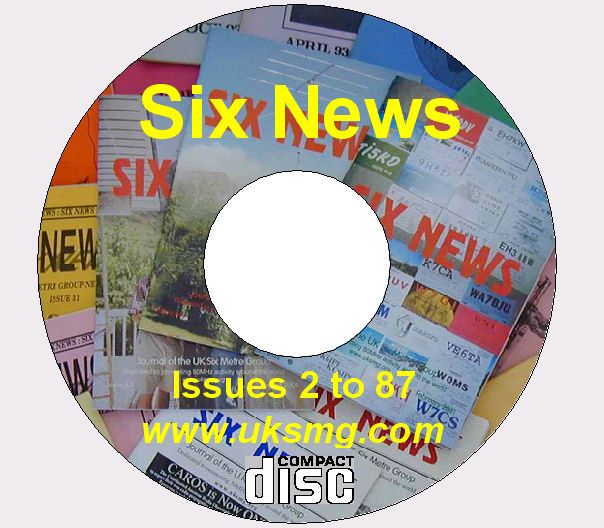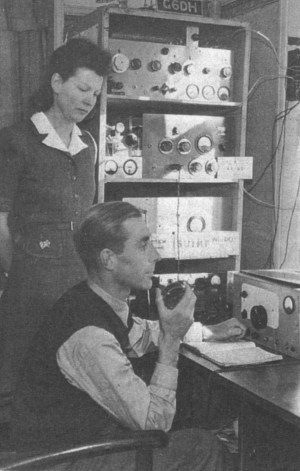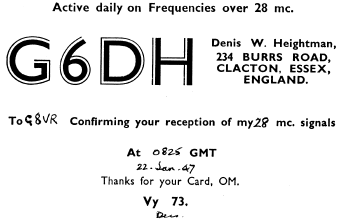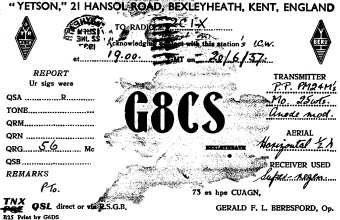

home > archive > the history of 6m > a bit of 5m history, G6DH

Thanks to all of our authors since 1982!
A bit of 6m History, G6DH - Ken Willis, G8VR |
|
|
For some years following the end of WWII, things were hard to come by and very expensive. I was living in south east London at the time, and my radio equipment was very primitive and all home-brew. By way of an antenna I had just a length of wire tied to a convenient tree. Ten metres was the ‘magic band’ in those days, and I was well aware of its potential because in 1937, as a SWL I caught the end of the previous sunspot cycle and heard a lot of USA stations at (to me) ‘phenomenal’ signal strengths on my three valve receiver. In January 1946 we were close to the peak of Cycle 18, so before leaving for work each morning, I would check 28 MHz, hoping that it might open early to the east. On several such occasions I heard Denis Heightman, G6DH, in Clacton, Essex, at exceptionally high signal strengths. Eventually I dropped him a card, and in a day or so he sent a reply, writing on the back of his card: "I am investigating the reason for hearing these short-distance signals. It appears that they go out at a low angle, say for about 1500 miles, and are reflected by the ionosphere almost at normal incidence, back to where they came from. The only requirement is that both TX and RX beams point in the same direction and that there is sufficient daylight (ionisation) in that direction. In the mornings it is to the east, but at 1400 one can point the beams anywhere from east to north-west and get reflections". There is little doubt that G6DH, whose main interest was the radio spectrum above 28 MHz, was experiencing ionospheric backscatter at that time. In 1946 UK amateurs had an allocation at 56 MHz, but in other parts of the world operation was permitted on 50 MHz. G6DH, who was a professional radio engineer, built a very nice receiver for 50 MHz and also had a small beam antenna for the band. On November 24th 1946, just before noon, he began hearing 50 MHz signals from the USA. Replying on 28 MHz, he is reported to have startled the household by shouting "I am hearing you on 50 Megacycles" into the microphone to Ed Tilton, W1HDQ the station at the far end. During the year which followed, the RSGB urged the licensing authority to consider granting G6DH special permission to transmit on six metres. Meanwhile he carried out the necessary modifications to his 56 MHz transmitter.
The QSL card of 50MHz pioneer G6DH A special licence was issued on November 5th 1947. That same day G6DH completed the first six metre two-way transatlantic contact, Ed W1HDQ again being the station at the USA end. Signals were S9+ in Clacton and S7 in Connecticut. Two days later G6DH worked MD5KW in the Suez Canal Zone, the station of none other than Major Ken Ellis, G5KW Royal Signals, who later became a founder member of the UK Six Metre Group. Ken I have known for many years, but it was quite by chance, some thirty years after these events, that I ran into W1HDQ, still a very active 50 MHz operator, in a radio store in Hartford, Connecticut.
A QSL card received by 2CIX (aka G8VR) on 'Approximately Six Metres'! Ten years before this, in 1937, I was using a super-regen receiver on or about 56 MHz (see "Approximately Six Metres", Six News No. 40) which put out so much hash that it would have served quite well as a transmitter! I held the artificial aerial call 2CIX at the time, so I could listen but not transmit. The first DX I copied was G8CS sending MCW with his 25-watt self-excited two-valve push-pull transmitter from his location at least two miles distant. Happy days, a far cry from the 400-plus watts and 7 element arrays of today, but it was great fun. UKSMG Six News issue 67, November 2000 |
the early history of 6m
six in fifty-seven
down memory lane
6m history
historical 6m
rigs
50yrs of 50megs
pt1
50yrs of 50megs
pt2
50yrs of 50megs pt3
50yrs of 50megs pt4
 Denis
Heightman, G6DH with XYL Eileen.
Denis
Heightman, G6DH with XYL Eileen.
